Archaeology in Action: Ceramic Analysis Using pXRF
Posted on April 26, 2023 by Lance Greene
My name is Lance Greene. I’m a historical archaeologist and Anthropology professor at Wright State University in Dayton, Ohio. I had the privilege to work for a brief period doing ceramic analysis on the I-10 Mobile River Bridge (MRB) Archaeological Project. I was most interested in the historic pottery dating to the 18 th and early 19 th centuries, when people from various colonial (and later American) powers interacted with numerous Native American groups in the region. I looked at Native American pottery, which was made by hand, usually with the coil method, and fired in open fires. That pottery is unglazed. I also looked at European pottery, which was generally turned on a wheel, glazed, and fired in a kiln.
I wanted to figure out who made the Native American pottery—there were several tribes in Mobile area during the era, such as the Alabamas, Mobilians, Pascagoulas, Tomés, Chatos, Biloxis, Apalachee, and Choctaws. It’s also possible that some of the pottery was made by enslaved Africans. For the European pottery, I wanted to see what types were being imported. These types, often highly decorated, include pottery from Spain, France, Britain, and Mexico.
Luckily, I got access to a really interesting kind of technology that is relatively new to archaeology—portable X-Ray Fluorescence (pXRF). Portable XRF emits X-rays that enable the portable device to define the elemental make-up of an object. It is often used to analyze metals, rocks, and artifacts. I had a lot of questions that I hoped pXRF could help answer: 1) Where did different ceramic sherds come from? 2) How similar in composition are the different ceramic types? 3) Can we identify the “recipes” for different glazes or clays?
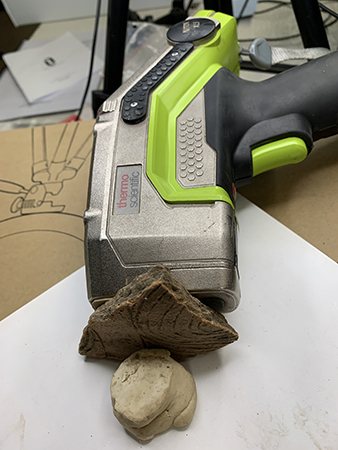
Scanning a ceramic sherd with pXRF
For my analysis, I separated the ceramics into two groups: glazed and unglazed. The pXRF helped define the “recipe” for the glazes (most glazes included some combination of aluminum, lead, iron, and silicon), and the natural and added constituents of handmade (unglazed) pottery. The results of the pXRF analysis include 36 elements. The most common constituents are silicon, aluminum, lead, and potassium. Minor constituents include zinc, arsenic, tungsten, and copper.
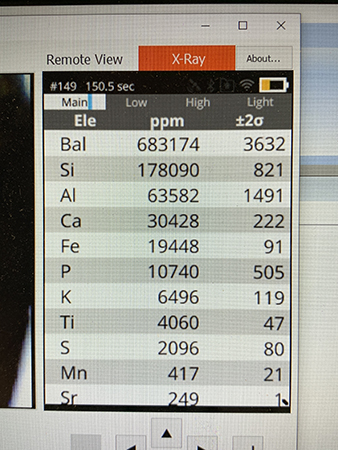
Results of pXRF scan showing most common elements
To help identify patterns in the data, I used Principal Component Analysis, or PCA. PCA is a statistical method that identifies broad patterns in large sets of data. In this case it looked for differences in elemental composition for different sherds. Glazed ceramics found during the I-10 MRB project include tin-glazed, lead-glazed, and salt-glazed pottery produced in Spain, France, Britain, and Mexico. Specific wares include types like Puebla Polychrome (made in Mexico, below), Faience (France), and porcelain (China).
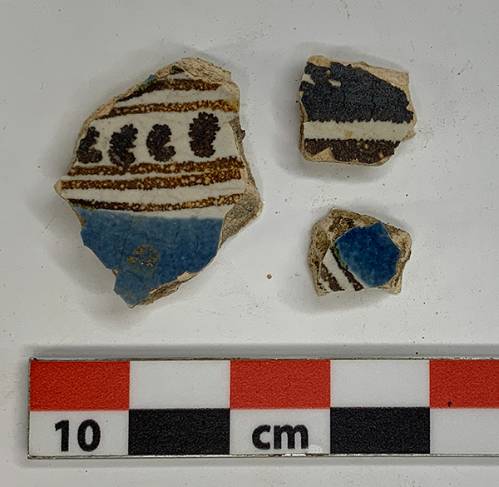
Left: Puebla Polychrome sherds from vessels produced in Mexico.
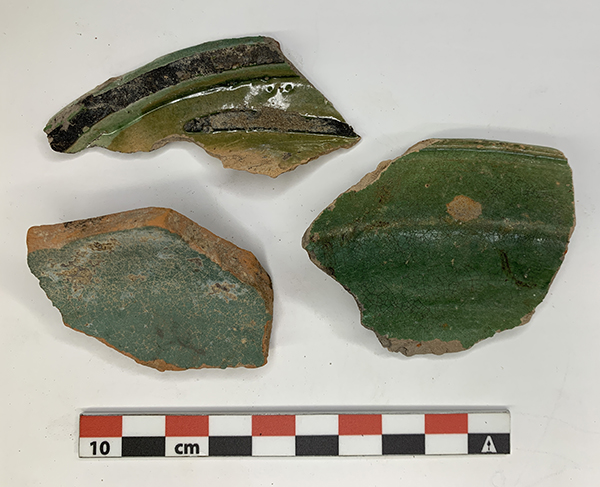
Right: Saintonge sherds from vessels produced in France.
In the PCA plot (below), several groups are obvious. Sherds within ceramic types like Faience, Saintonge, stoneware, porcelain, pearlware, and whiteware all clustered together. These cluster refer to similar groups of elements identified in the pXRF analysis. For example, Faience has much higher levels of magnesium and nickel. It also has high levels of tin, even higher than the other tin-glazed sherds. The Saintonge sherds (pictured above, clustered in the upper right hand corner in the graph below) are distinctive because of their high levels of zinc, molybdenum, selenium, tungsten, and copper.
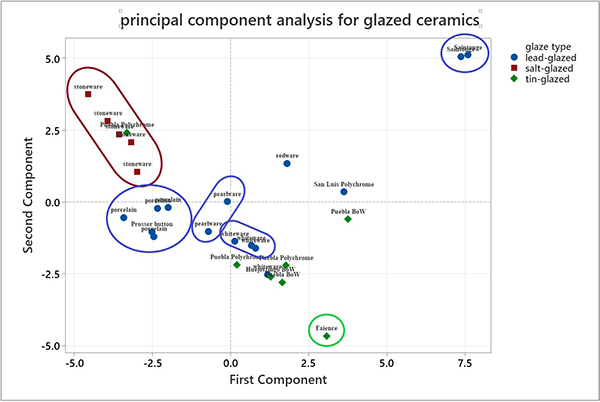 PCA graph showing groups of European ceramics. Clustered groups are circled.
PCA graph showing groups of European ceramics. Clustered groups are circled.
Unglazed (hand-built/coiled) ceramics on the I-10 MRB project were made by Native Americans and possibly by enslaved Africans. The goal was to observe differences in the natural constituents of the clay, which could help identify the clay source. Also, I wanted to see if I could start to identify the “recipe” for the red film or slip that was added to many small vessels (below).
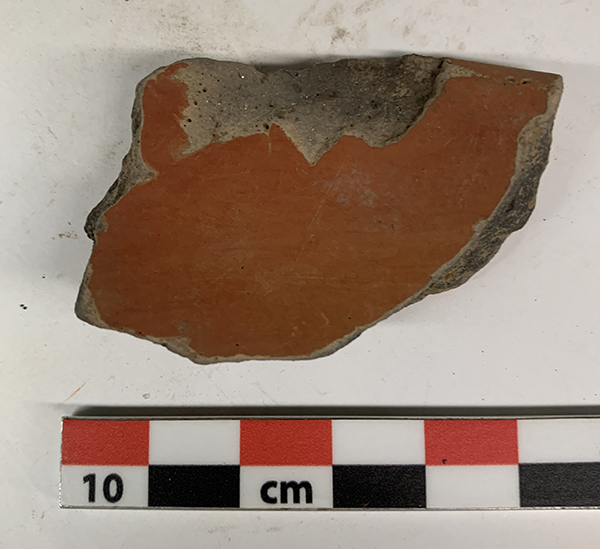
Red-filmed sherd from the I-10 MRB Project
Unlike the PCA for glazed sherds, statistical analysis did not immediately show any clear groups. The PCA graph shows that the different types are scattered (below). This result likely means that these ceramics were made in the Mobile area from similar clays. However, the red-filmed sherds appear more broadly scattered, showing that the composition of the red film or slip has a wider variety of constituents than the non-slipped sherds. It looks like there was some variety in the “recipe” for this vessel treatment.
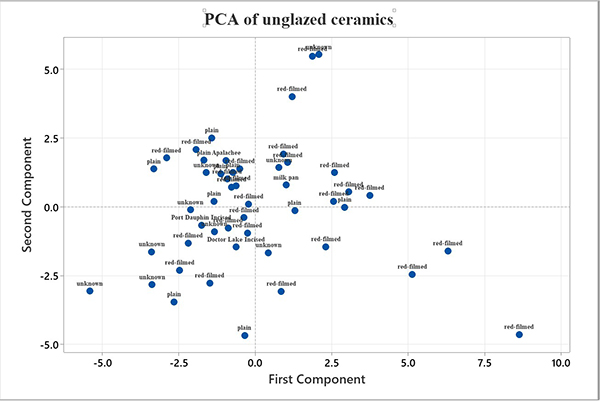 PCA graph of unglazed sherds
PCA graph of unglazed sherds
It isn’t surprising that the glazed ceramics show more distinctive groups than the unglazed pottery. The European ceramics were produced by potters from several countries who used different combinations of ingredients for their glazes. However, the PCA analysis of the unglazed sherds also reveals information on how red filming was prepared. The distinctive groups that appear in the PCA analysis show that pXRF can be a useful technology in the analysis of ceramics.
Our research for the I-10 Mobile River Bridge Archaeology Project is ongoing. Continue to follow along as we share updates from our work! For more information about archaeological lab work, check out Chelsea Cook’s recent post in the Archaeologist’s Toolkit series.


